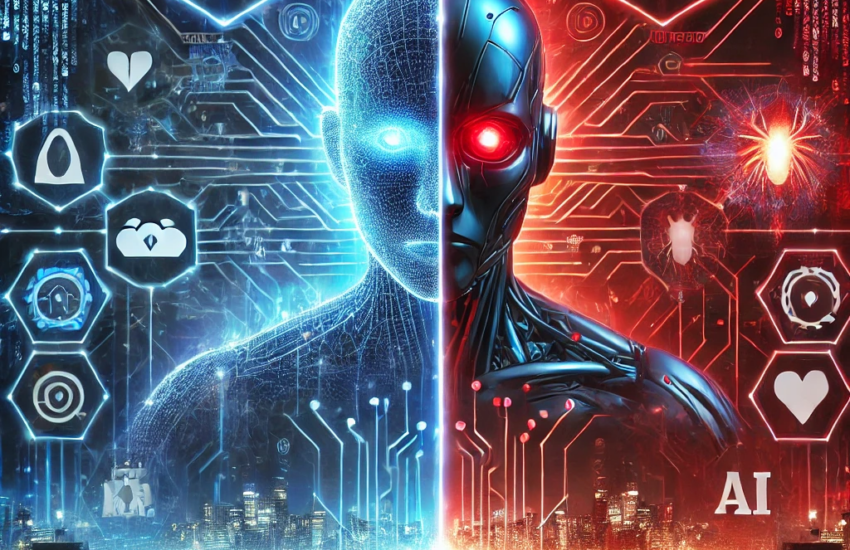In today’s rapidly evolving digital landscape, Artificial Intelligence has become both our strongest ally and most formidable adversary in cybersecurity. As a cybersecurity consultant specializing in both OT and IT environments, I’ve witnessed firsthand how AI is revolutionizing the way we approach digital security – for better and worse.
The Defensive Shield: How AI Protects Our Digital Assets
Enhanced Threat Detection
Imagine a security guard who never sleeps, can monitor millions of events simultaneously, and learns from every interaction. That’s AI in defensive cybersecurity. Modern AI systems can detect threats that would be impossible for human analysts to catch in real-time.
Real-World Example: A major financial institution implemented AI-powered network monitoring that detected and blocked a sophisticated ransomware attack by identifying unusual file encryption patterns at 3 AM, before any data could be compromised. The AI system recognized the behavior pattern from analyzing millions of previous attacks, something no human team could achieve.
Automated Incident Response
When seconds count, AI delivers. Modern security systems use AI to automatically:
- Isolate infected systems
- Block suspicious IP addresses
- Alert security teams
- Begin incident documentation
Case Study: A manufacturing plant’s OT network recently faced a potential breach. The AI-powered security system detected unusual commands being sent to critical PLCs, immediately isolated the affected network segment, and alerted the security team – all within 2.3 seconds of the first suspicious activity.
The Dark Side: AI-Powered Cyber Attacks
Advanced Social Engineering
Cybercriminals are now using AI to create increasingly sophisticated phishing campaigns. These attacks use natural language processing to:
- Craft personalized spear-phishing emails
- Generate convincing deepfake voice calls
- Create realistic social media profiles for social engineering
Real Example: In 2023, several organizations fell victim to AI-generated voice cloning attacks where criminals used deepfake technology to impersonate CEOs in calls to financial departments, successfully initiating fraudulent wire transfers.
AI-Enhanced Malware
Modern malicious software is becoming increasingly intelligent. AI-powered malware can:
- Adapt to avoid detection
- Learn from failed attempts
- Modify its code on the fly
- Target specific vulnerabilities in systems
Industrial Impact: In manufacturing environments, AI-powered malware has shown the ability to learn normal operational patterns and hide malicious activities within regular system behavior, making traditional detection methods obsolete.
The Corporate Battlefield
Enterprise Defense Strategies
Large organizations are increasingly adopting AI-powered security operations centers (SOCs) that provide:
Continuous Monitoring and Analysis
A Fortune 500 manufacturing company reduced its incident response time by 87% by implementing AI-powered security monitoring. The system processes over 1 million security events per second, automatically correlating and prioritizing threats that would have taken human analysts weeks to analyze.
Predictive Security
AI systems are now capable of predicting potential security breaches before they occur. One energy company’s AI system identified vulnerable IoT devices in their OT network and predicted potential attack vectors, allowing for preemptive security measures.
The Cost of Innovation
However, this technological arms race comes at a price. Organizations must consider:
- Initial implementation costs
- Ongoing training and maintenance
- Integration with existing systems
- Compliance with regulatory requirements
Individual Impact and Protection
Personal Privacy Concerns
AI affects individual privacy in numerous ways:
Digital Footprint Analysis
AI systems can now create detailed personal profiles by analyzing public data, making individual privacy protection more crucial than ever.
Smart Device Vulnerability
The average smart home now has 22 connected devices, each potentially vulnerable to AI-powered attacks.
Personal Protection Strategies
Individuals can leverage AI-powered tools for protection:
- Smart password managers that adapt to personal usage patterns
- AI-powered email filters that learn from user behavior
- Intelligent fraud detection in personal banking apps
The Regulatory Landscape
The implementation of AI in cybersecurity must navigate complex regulatory requirements:
- GDPR compliance for AI systems processing personal data
- NIS2 Directive requirements for critical infrastructure
- Industry-specific regulations like HIPAA in healthcare
Looking Forward: The Future of AI in Cybersecurity
As we stand at this technological crossroads, it’s clear that AI in cybersecurity is both a powerful tool and a significant challenge. Organizations and individuals need expert guidance to:
- Develop comprehensive AI security strategies
- Ensure regulatory compliance
- Maintain effective defense against AI-powered threats
- Balance security with operational efficiency
As a cybersecurity consultant with expertise in both business management and technical implementation, I help organizations navigate this complex landscape. My experience in aligning cybersecurity goals with business objectives, combined with deep understanding of AI applications in security, enables me to guide clients through successful AI integration while maintaining robust security postures.
Conclusion: The Need for Expert Guidance
The integration of AI in cybersecurity isn’t just a technological shift – it’s a fundamental transformation in how we approach digital security. Whether you’re a large corporation protecting critical infrastructure or an individual safeguarding personal data, understanding and effectively implementing AI-powered security solutions is crucial.
The complexity of this landscape demands expert guidance. With my dual expertise in business management and cybersecurity, specializing in GRC and OT environments, I can help you navigate these challenges.
From developing comprehensive security strategies to ensuring regulatory compliance, I provide the insights and direction needed to leverage AI effectively while managing associated risks.
Ready to enhance your cybersecurity posture with AI? Let’s discuss how we can work together to protect your digital assets in this evolving threat landscape.
_This comprehensive overview demonstrates the multifaceted nature of AI in cybersecurity, but it’s just the beginning. Each aspect deserves deeper exploration, which I’ll cover in future posts. Stay tuned for more insights into specific applications, challenges, and solutions in AI-powered cybersecurity._


